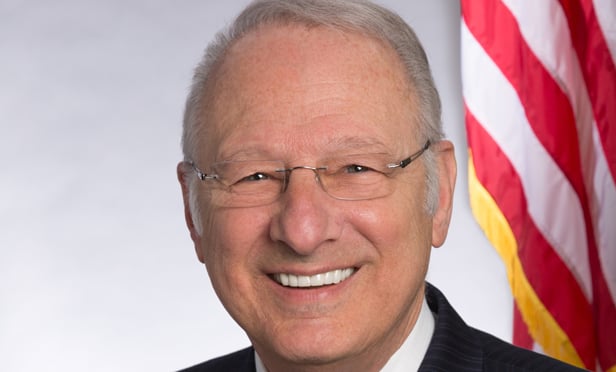 “Our cap rates are realistic,” says Cosenza. “A seller’s is always much rosier.”
“Our cap rates are realistic,” says Cosenza. “A seller’s is always much rosier.”
OAK BROOK, IL–Maybe it’s the confidence that stems from coming off a record year. Or maybe it’s the confidence that made a record year possible. Or maybe it’s just Joe. But Inland Real Estate Group vice chairman Joseph Cosenza clearly takes the ups and downs of the market in stride.
The firm is building on a stellar 2015, and as GlobeSt.com reported, topping the $40-billion acquisition mark with virtually no help from large portfolio deals. The calendar year alone contributed nearly $2 billion to that goal.
“For 2016, I can’t see that changing much,” says Cosenza. Except that the firm is already blowing out its portfolio with four new apartment complexes, three more in contract and “a ton more in negotiation,” he says. As for retail, “we expect a surge because of the institutional fund we launched last year.”
Inland has a somewhat contrarian view to acquisition in that, as Cosenza states, he doesn’t buy by market. At least not initially. “I love this question,” he says. “It’s not the market I target. It’s the property. If you don’t like the brick-and-mortar, what does the market matter, unless you’re a developer looking to level the asset and start over?
“I think in terms of the property and if it fits the parameters of any of my entities,” he continues. “Does it have the right tenants, the right location, the right traffic patterns?” Only then “can we ask if it’s in a market we’re comfortable with. If I chose only certain markets to buy in, it would be a big mistake. It would be like choosing to use only one hand in a fist fight.”
Walkability is a big part of the investment criteria these days for Inland. Good thing, given the trend GlobeSt.com has covered in the past, tracking Millennials and their Baby Boom parents as they transition from the suburbs to closer-in and transit-oriented developments.
But in the everything-old-is-new-again category, Cosenza reminds us that we’ve seen it all before. “It goes back to an era when some of us as kids were living in the city and we could walk the two or three blocks to the A&P, the fashion store for my mom, the Woolworth and the Five and Dime. Everything was at my fingertips.”
But a trip down Memory Lane leads us back to business, and Cosenza rattles off a number of assets in his portfolio that reflect the growing trend, typical of which is a Giant Food Center in Owensville, MD. “The entire local population–almost 20,000 people–lives within a mile of that store,” he says. “That’s why they’re doing over $30 million.”
And, as apartments feed retail, retail–literally and figuratively–feeds multifamily in what can only be called a symbiotic real estate relationship. “Close retail is one of the reasons why occupancy is so doggone tight,” Cosenza says.
And indications are that both should remain so, at least for the foreseeable future, although Cosenza doesn’t see an explosive year. “The economy is just inching up little by little,” he says. “Maybe at the end of the year it might be a little different.”
Which brings up interest and cap rates. “For June, they absolutely shouldn’t raise the rate. Maybe that too will be a little different by the end of the year.”
Not if we’ve peaked. “But retail is good, and I don’t see much negativity. Sure, Sports Authority and Vestis Retail, the parent company of Sports Chalet, have filed for bankruptcy. And we’ll see a little of this here and there. But this is not 2009 or 2010.
“Now, for cap rates,” he continues. “The best shopping centers–and everyone knows what that is because all you have to do is go up to it and you’ll say, ‘Man I’d love to own this!’–Those can cost me anywhere from the mid-fives to a 6%.”
This, he says, compares to an apartment complex (the best, “and you know what they are”) and these can cost from “the low- to mid-fives.”
But with these cap rates comes a caveat: “This presumes we’re talking about Inland’s underwriting and not the seller’s,” he says. “Ours is realistic. A seller’s is always much rosier.”
So are we at the peak? “I still think there’s real pressure on cap rates,” he says. “Will retail remain a safe bet? It comes back to our focus on the product and not the market. It depends on what you buy. That sounds like a copout, but you tell me who the grocer is. Tell me their sales per square foot. Tell me the average number of times a person visits that center in a week and I’ll tell you if it’s a safe bet. They’re all different. What it comes down to is that there really is no safe bet.”
And if the target property doesn’t measure up? “I didn’t see as many of the best types of grocery-anchored shopping centers available in the marketplace in the first few months of this year. I don’t know why but I don’t think it was because we’re peaking. But I can wait.”
Now that’s confidence.

















 Copyright © 2024 ALM Global, LLC. All Rights Reserved.
Copyright © 2024 ALM Global, LLC. All Rights Reserved.